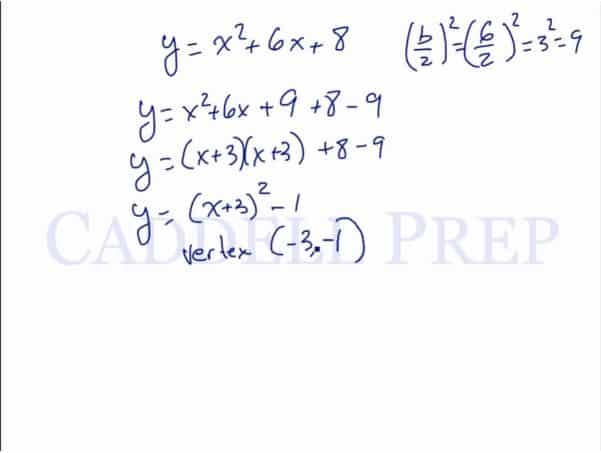In this video, we are going to look at the vertex form of a quadratic equation. After you finish this lesson, view all of our Algebra 1 lessons and practice problems.
If we look at a regular quadratic function such as and want to shift it to the right 3 units and down 4 units, then we know that the modified equation would be
*Horizontal shifts are located within the parenthesis and vertical shifts are located outside of the parenthesis*
From this equation, we can clearly see that the vertex point is at (3,-4).
This form is very useful in identifying the coordinates of the vertex.
If we were given an equation in standard form, we can complete the square to get it to vertex form.
For example:
To solve by completing the square, we want to solve for the number to add by using
So:
This means that we have to add 9 to complete the square. However, if we add 9 then it changes the formula. To counteract that, we will also subtract 9.
Let’s focus on the first three terms in the equation.
When we factor those terms, we get
or
Now, we have written the equation in vertex form. From here, we can see that the vertex is at (-3,-1).
Examples of Vertex Form Of A Quadratic Equation
Example 1
To solve by completing the square, we want to solve for the number to add by using
This means that we have to add to complete the square. To counteract that, we will also subtract
.
Let’s focus on the first three terms in the equation.
When we factor those terms, we get
or
Now, we have written the equation in vertex form. From here, we can see that the vertex is at .
Example 2
To solve by completing the square, we want to solve for the number to add by using
This means that we have to add to complete the square. To counteract that, we will also subtract
.
Let’s focus on the first three terms in the equation.
When we factor those terms, we get
or
Now, we have written the equation in vertex form. From here, we can see that the vertex is at .
Video-Lesson Transcript
Let’s go over vertex form of a quadratic equation using completing the square.
A basic quadratic function looks like a letter “U” with a form
We could write this anywhere on the graph. Up, down, left, or right.
Now, if we want our line to be down by and move right by
, then we should also adjust the basic quadratic equation by the same number.
So now our equation is
From here, we can tell that the vertex is
But if we want to go left by and up by
, our new equation is
From here, you can tell that vertex is at
Let’s do another one.
Let’s go up by and move right by
.
Here, our new equation is
And our vertex is
The equation form above is very useful in finding the vertex.
But what happens when you are given a standard equation like this:
How do we translate this into the previous form?
We can do that by completing the square.
For example:
Let’s transform this into the vertex form.
We want to complete the squares.
To do so, let’s use this formula for the -term
Let’s continue completing the square
Let’s just focus on the first three terms since it’s a perfect square.
So now we arrive at the vertex form.
We can already identify the vertex
Let’s look at one more
Let’s solve the -term first
Let’s go back to the equation and factor
From this vertex form of a quadratic equation, we can already say that vertex is



